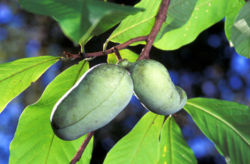Asimina triloba
| Asimina triloba subsp. var. | ||||||||||||||||||||||||||||||||||||||||||||||||||||||||
|---|---|---|---|---|---|---|---|---|---|---|---|---|---|---|---|---|---|---|---|---|---|---|---|---|---|---|---|---|---|---|---|---|---|---|---|---|---|---|---|---|---|---|---|---|---|---|---|---|---|---|---|---|---|---|---|---|

|
|
| ||||||||||||||||||||||||||||||||||||||||||||||||||||||
| ||||||||||||||||||||||||||||||||||||||||||||||||||||||||
| Standard Cyclopedia of Horticulture |
|---|
|
Asimina triloba, Dunal (Annonalrtloba, Linn.). Fig. 401. Small tree, 10-40 ft. : Lvs. cunéate, obovate-oblong, acute, ½-1 ft. long, glabrous: fls. with the Lvs. from branches of the previous year, green when expanding, changing to purplish red, with yellow in the middle, 2 in. broad: fr.oblong, 2-6 in. long, dark brown. S. states, north to N. Y., west to Mich, and Kan. S.S. 1:15, 16. B.M. 6854. Gn. 33, p. 321. G.F. 8:495. A.G. 44:713. R.H. 1911, pp. 134, 135.—This is the only arborescent species of the genus. It is well worth a place in the garden, for its large foliage is very handsome and the fls., appearing in the early spring, are attractive. The large fr. is edible, and may be still improved by cult, and careful selection of the best varieties. Many persons do not relish the highly aromatic flavor; and the large seeds are a disadvantage. The tree has proved hardy in Mass, and Ont. One or 2 named forms have been offered.
|
| Pawpaw {{{status}}} Fossil range: {{{fossil_range}}}
| ||||||||||||||||||||||||||||||||||||||||||||||||||||||||||||||||||
|---|---|---|---|---|---|---|---|---|---|---|---|---|---|---|---|---|---|---|---|---|---|---|---|---|---|---|---|---|---|---|---|---|---|---|---|---|---|---|---|---|---|---|---|---|---|---|---|---|---|---|---|---|---|---|---|---|---|---|---|---|---|---|---|---|---|---|
 Common Pawpaw in fruit | ||||||||||||||||||||||||||||||||||||||||||||||||||||||||||||||||||
| Plant Info | ||||||||||||||||||||||||||||||||||||||||||||||||||||||||||||||||||
| ||||||||||||||||||||||||||||||||||||||||||||||||||||||||||||||||||
| Scientific classification | ||||||||||||||||||||||||||||||||||||||||||||||||||||||||||||||||||
| ||||||||||||||||||||||||||||||||||||||||||||||||||||||||||||||||||
| [[{{{diversity_link}}}|Diversity]] | ||||||||||||||||||||||||||||||||||||||||||||||||||||||||||||||||||
| {{{diversity}}} | ||||||||||||||||||||||||||||||||||||||||||||||||||||||||||||||||||
| Binomial name | ||||||||||||||||||||||||||||||||||||||||||||||||||||||||||||||||||
| Asimina triloba (Linnaeus) Michel Félix Dunal | ||||||||||||||||||||||||||||||||||||||||||||||||||||||||||||||||||
| Trinomial name | ||||||||||||||||||||||||||||||||||||||||||||||||||||||||||||||||||
| {{{trinomial}}} | ||||||||||||||||||||||||||||||||||||||||||||||||||||||||||||||||||
| Type Species | ||||||||||||||||||||||||||||||||||||||||||||||||||||||||||||||||||
| {{{type_species}}} | ||||||||||||||||||||||||||||||||||||||||||||||||||||||||||||||||||
| {{{subdivision_ranks}}} | ||||||||||||||||||||||||||||||||||||||||||||||||||||||||||||||||||
| [[Image:{{{range_map}}}|{{{range_map_width}}}|]] | ||||||||||||||||||||||||||||||||||||||||||||||||||||||||||||||||||
| Synonyms | ||||||||||||||||||||||||||||||||||||||||||||||||||||||||||||||||||
| {{{synonyms}}} |
The Common pawpaw (Asimina triloba) is a species of pawpaw, native to eastern North America, from southernmost Ontario and New York west to eastern Nebraska, and south to northern Florida and eastern Texas.
Description
Pawpaw is a large shrub or small tree growing to a height of 11 meters (rarely to 14 m) with a trunk diameter of 20-30 cm.
The leaves are deciduous, spirally arranged, broad lanceolate, 15-30 cm long, with an acute apex and an entire margin.
The flowers are produced in early spring at the same time as or slightly before the new leaves appear, each flower dark red, 2-5 cm diameter, with three sepals and six petals; they have a fetid smell.
The fruit is a large yellow-green berry 5-15 cm long, containing several brown, 15-25 mm diameter seeds embedded in the soft, edible fruit pulp.
Conservation status
On a global scale, the common pawpaw has a Global GRANK of G5 (Very Common).
The common pawpaw is considered a threatened species in New York, and an endangered species in New Jersey.
In Canada, it is only found in portions of southern Ontario, where it has a National NRANK of N3 (Vulnerable) and a Provincial SRANK of S3 (Vulnerable). The Ontario Ministry of Natural Resources has given A. triloba a general status of "Sensitive", and its populations are monitored.
Biochemistry
The fruit is rich in fatty acids, the major one being octanoate. They also contain cis-δ9- and cis-δ11-hexadecenoate, cis-δ9-, cis-δ11- and cis-δ13-octadecenoate.
The seeds have been shown to contain the chemicals asimitrin (an adjacent ring-hydroxylated bis-tetrahydrofuran acetogenin) and 4-hydroxytrilobin (an adjacent bis-THF ring with two flanking hydroxyl groups and an α,β-unsaturated γ-lactone with a 4-hydroxyl group). These chemicals seem to have selective cytotoxicity against prostate adenocarcinoma (PC-3) and colon adenocarcinoma (HT-29) cell lines, thus may become a useful chemotherapeutic chemical for these types of cancer.
The leaves also contain toxic annonaceous acetogenins, making them impalatable to most insects. The one notable exception is the zebra swallowtail butterfly (Eurytides marcellus), whose larvae feed on the leaves. This confers protection from predation throughout the butterfly's life, as trace amounts of acetogenins remain present, making them impalatable to birds and other predators.
The bark contains other acetogenins, including asimin, asiminacin and asiminecin, which have been shown to be potent inhibitors of mitochondrial NADH:ubiquinone oxidoreductase, making A. triloba a promising source of pesticide and anti-tumour compounds.
References and external links
- Flora of North America: Asimina triloba
- USDA Plants Profile: Asimina triloba
- Asimina triloba images at bioimages.vanderbilt.edu
- Natural Heritage Information Centre / Centre d'information des heritages naturelles — Asimina triloba. Ontario Ministry of Natural Resources / Ministère des richesses naturelles. Queen's Printer for Ontario, 2002. Accessed 4 May 2006.
- Kim, E.J.; K.M. Suh, D.H. Kim, E.J. Jung, C.S. Seo, J.K. Son, M.H. Woo and J.L McLaughlin (February 2005). "Asimitrin and 4-hydroxytrilobin, new bioactive annonaceous acetogenins from the seeds of Asimina triloba possessing a bis-tetrahydrofuran ring". Journal of Natural Products 68 (2): 194-7. http://www.ncbi.nlm.nih.gov/entrez/query.fcgi?cmd=Retrieve&db=pubmed&dopt=Abstract&list_uids=15730242&query_hl=33&itool=pubmed_docsum.
- J.M. Martin, S.R. Madigosky, Z.M. Gu, D. Zhou, J. Wu and J.L. McLaughlin. Chemical defense in the zebra swallowtail butterfly, Eurytides marcellus, involving annonaceous acetogenins. Journal of Natural Products. 1999 Jan; 62(1):2-4.
- G.X. Zhao, L.R. Miesbauer, D.L. Smith and J.L. McLaughlin. Asimin, asiminacin, and asiminecin: novel highly cytotoxic asimicin isomers from Asimina triloba. Journal of Medicinal Chemistry. 1994 Jun 24; 37(13):1971-6.